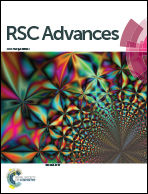Triply-bonded indium![[triple bond, length as m-dash]](https://www.rsc.org/images/entities/char_e002.gif) phosphorus molecules: theoretical designs and characterization†
phosphorus molecules: theoretical designs and characterization†
Abstract
The effect of substitution on the potential energy surfaces of triple-bonded RIn![[triple bond, length as m-dash]](https://www.rsc.org/images/entities/char_e002.gif) PR (R = F, OH, H, CH3, SiH3, NHC, SiMe(SitBu3)2 and SiiPrDis2) species was investigated, using the density functional theory (i.e., M06-2X/Def2-TZVP, B3PW91/Def2-TZVP and B97-D3/LANL2DZ+dp). The theoretical results suggest all of the triple-bonded RIn
PR (R = F, OH, H, CH3, SiH3, NHC, SiMe(SitBu3)2 and SiiPrDis2) species was investigated, using the density functional theory (i.e., M06-2X/Def2-TZVP, B3PW91/Def2-TZVP and B97-D3/LANL2DZ+dp). The theoretical results suggest all of the triple-bonded RIn![[triple bond, length as m-dash]](https://www.rsc.org/images/entities/char_e002.gif) PR molecules prefer to adopt a bent form with an angle (∠In–P–R) of about 90°. Present theoretical evidence suggests only the bulkier substituents, in particular for the strong donating groups (such as the NHC group), can greatly stabilize the In
PR molecules prefer to adopt a bent form with an angle (∠In–P–R) of about 90°. Present theoretical evidence suggests only the bulkier substituents, in particular for the strong donating groups (such as the NHC group), can greatly stabilize the In![[triple bond, length as m-dash]](https://www.rsc.org/images/entities/char_e002.gif) P triple bond. In addition, bonding analyses demonstrate the bonding character of such triple-bonded RIn
P triple bond. In addition, bonding analyses demonstrate the bonding character of such triple-bonded RIn![[triple bond, length as m-dash]](https://www.rsc.org/images/entities/char_e002.gif) PR compounds should be represented as
PR compounds should be represented as  . That is to say, the In
. That is to say, the In![[triple bond, length as m-dash]](https://www.rsc.org/images/entities/char_e002.gif) P triple bond contains one traditional σ bond, one traditional π bond, and one donor–acceptor π bond. As a consequence, the theoretical findings strongly suggest the In
P triple bond contains one traditional σ bond, one traditional π bond, and one donor–acceptor π bond. As a consequence, the theoretical findings strongly suggest the In![[triple bond, length as m-dash]](https://www.rsc.org/images/entities/char_e002.gif) P triple bond in acetylene analogues (RIn
P triple bond in acetylene analogues (RIn![[triple bond, length as m-dash]](https://www.rsc.org/images/entities/char_e002.gif) PR) should be very weak.
PR) should be very weak.
![Graphical abstract: Triply-bonded indium [[triple bond, length as m-dash]] phosphorus molecules: theoretical designs and characterization](/en/Image/Get?imageInfo.ImageType=GA&imageInfo.ImageIdentifier.ManuscriptID=C7RA01295K&imageInfo.ImageIdentifier.Year=2017)


 Please wait while we load your content...
Please wait while we load your content...
![[triple bond, length as m-dash]](https://www.rsc.org/images/entities/h2_char_e002.gif) phosphorus molecules: theoretical designs and characterization
phosphorus molecules: theoretical designs and characterization